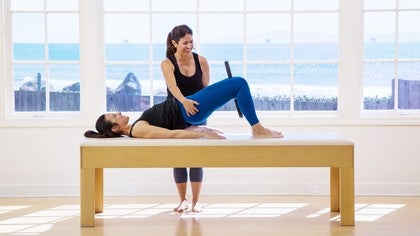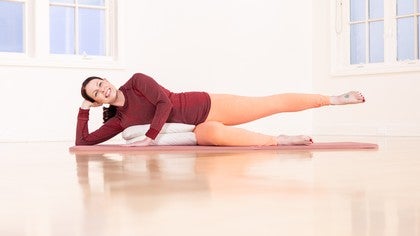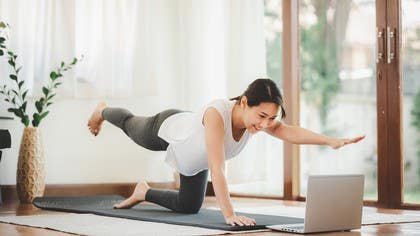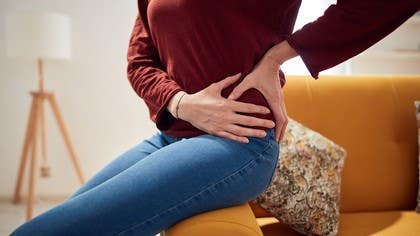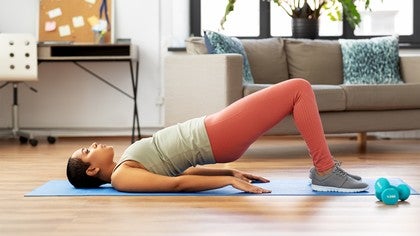
How Pilates Helps Prevent Falls
As we age, we naturally lose strength. Muscle mass decreases three to eight percent per decade after the age of 30. As muscle fibers shrink, fat gradually replaces some of the muscle volume. When this common aging process occurs, muscles have less ability to contract. Over time, they lose strength, making leg weakness one of the biggest causes of injurious falls.
Is the modern sedentary lifestyle a contributing factor? It seems that way. Given that muscles adapt to the stresses placed upon them, we need to look at the activities we participate in and think about how many hours we spend sitting relative to the hours we spend walking or standing.
Can Pilates help change these numbers?
The good news is that falls are preventable and as Pilates instructors we can do so a great deal to reverse these statistics.
Pilates Mat and Studio exercises offer endless opportunities for improving strength. Because so much of the repertoire (Mat especially) is performed on the floor, an instructor’s creativity and understanding of fall prevention is key when working with this growing population of seniors. It is important to keep in mind some other main factors when working with adults at risk for falls.
Beyond the natural loss of strength during the aging process, sedentary lifestyles, nutrient deficient diets, loss of balance and vision, and environmental factors play a role in causing falls in older adults.
The first changes we can take to reduce their chances of a near fatal fall are environmental. That means removing or safeguarding rugs, placing non-skid mats in showers and tubs, applying bright colored stickers around steps and glass sliding doors, and removing anything else that could potentially cause a slip or fall. We can ask the older adults in our lives to become more aware of moments when they experience dizziness. For example, if moving quickly from sitting to standing makes them dizzy, we can suggest that they move slowly and mindfully. In addition, we can encourage them to speak up and tell their doctor or pharmacist if they have had any episodes of feeling faint or dizzy, and to ask if any of their medications can cause dizziness or drowsiness.
One of the most serious injuries that results from a fall is a broken hip. Broken hips lead to a loss of independence and in some cases death. This common fracture is one of the main reasons older adults are forced to move into nursing homes. According to recent statistics from the International Osteoporosis Foundation, worldwide, one in three women over the age of 50 years and one in five men will experience osteoporotic fractures in their lifetime. 95 percent of these bone fractures are caused by falls. The data showing that individuals typically fall sideways offers an important clue for Pilates instructors designing a fall prevention program.
Leg strength and balance are the most important skills to work on in a Pilates fall prevention routine. Falls may be very common, but they do not have to be a normal part of the aging process. We can start early and get ahead of the statistics by bringing more awareness to the importance of weight-bearing exercises, for example by including standing work as part of a regular Pilates workout.
Given that the typical Pilates clients (middle-aged and older women) are also the most at risk for falls, instructors need to ensure that our sessions include working on balance, leg strength, and coordination.
The High Chair is a very powerful tool for fall prevention. Exercises like Standing Leg Pump or Standing Leg Press strengthen the legs, mobilize the hips in a functional way, and improve balance. We can start this exercise using the arms for support if our client has balance challenges. Over time, the client can progress to using no additional support, and eventually to standing on an uneven surface such as a partially deflated ball, an Oov, a Bosu ball, or a rotating disk.
Remember, building balance and strength is a process.
As a teacher, remember that safety is paramount, as is setting our clients up for success. One of the best ways to appropriately challenge clients is to start small. Begin by teaching something fairly simple that will allow the student to feel successful and then progressively add challenges.
For example, if we want a high-fall-risk client to build leg strength and improve balance, we can start by having her stand comfortably with legs hips-width apart and perform a basic squat that mimics the way she would move from sitting to standing. As we see that she is able to move smoothly in and out of the squat, we can ask her to put a little more weight into one leg, as if she were performing the same movement on only one leg. Before asking her to bring one leg up and balance, we can practice the weight shift, build up the expectation, and gradually reduce the dependence on one foot until she is able to fully lift that foot off the floor while performing the squat. In the Pilates Studio, we can do assisted squats off the end of the Trapeze Table to increase support and trunk organization.
Fall prevention has three key factors: improving balance, building balanced leg strength, and most importantly, building confidence. As a side benefit, doing Pilates workouts structured around these objectives will also increase leg and glute tone. And who doesn’t want that?
Comments
You need to be a subscriber to post a comment.
Please Log In or Create an Account to start your free trial.

